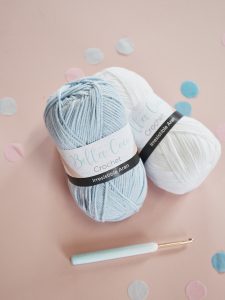New to crochet or want a quick refresher? Follow our handy guide for how to read a crochet pattern.
Reading a Pattern Line
There are many different ways to write a crochet pattern. Using numbered Rows or Rounds (Rnds) is the best way to keep your place in a pattern. Take notice of whether the pattern says Rows or Rnds, as it’ll also signify whether you should be working the piece flat or in the round if not stated already.
The instructions for working a basic stitch will be given with the instruction of how many stitches are worked in succession. For example, the instruction ‘4 dc’ will tell you to work a double crochet stitch into the next four available stitches on the row below. Increases are signified by the instruction ‘in the same st’ or ‘in the next st’.
Square brackets are used in patterns to show a complete instruction. This is followed by a further instruction outside the bracket. For example, ‘[3 dc, 2 dc in the next st] 4 times’ means that ‘3 dc, 2 dc in the next st’ will be worked four times in succession. Another way of indicating a repeat is to use *. This is followed by an instruction to repeat from * a certain number of times. Round brackets within pattern instructions will signify sizing. So, make sure you pay attention to the Sizing section of the project materials column. If a pattern states S (M, L) then in the instructions 20 (24, 28) dc, you work the number of stitches required that corresponds to the size you are working only.
About the yarn
If you can’t get hold of the pattern yarn, or want to substitute it for another yarn, this is important. Not only does it tell you the weight of yarn, it also gives an insight into the fibre make up. Furthermore, it indicates the yardage, so you can ensure you buy enough yarn length in the substituted yarn. If not, you might find yourself with a different dyelot, which could cause a subtle, but noticeable shift in the colour of your project.
Tension
For most crochet projects, a tension square is important – especially with wearable items such as garments, accessories and baby clothes. How tightly or loosely you crochet is important for sizing, so crocheting a small square in the suggested pattern is an indicator of whether the final project will turn out the right size. If your tension does not match the suggested tension, adjust your hook size as required. Many people do not look at tension for amigurumi toys, however, yours may end up a different size if you have a looser or tighter tension.
Special stitches
If you come across a term outside of the common abbreviations it may be a special stitch. Look out for separate instructions outside of the pattern, which will explain how to make the stitch.
Finishing
Apart from toys, most projects should be blocked to relax the yarn into its new shape. This is done by wetting the object, either in warm water, with a spray bottle or by steaming it. Then shape it and leave to dry. This can be just laid out flat, pinned out on a blocking or foam board or, with the likes of hats, some people even pop them over inflated balloons. You can find this at the end of a pattern.
How to read a chart
First, find the key. While you may recognise symbols from previous chart-reading experiences, remember that different people draw charts differently. As a result, what meant a treble stitch before may mean a half treble now. It will also contain special information needed to make sense of the chart.
You read a crochet chart from bottom to top when worked in rows. Or from the inside out when working in rounds. Rows are worked from right to left first, then left to right, continuing as set unless otherwise stated. While rounds are worked anti-clockwise, as you would crochet them. Small numbers with arrows signify where each Rnd starts – helpful for making sense of more complex charts, while also giving a clue of where to fasten off and join in colours. If there’s a jump between where you end the row and where you start the next, there’s a good chance that the colour has changed – sometimes this is signified in the colouring of the chart, sometimes not!
Ready to crochet? Check our of FREE crochet patterns.
If you’ve not yet subscribed to Crochet Society you are in for a treat! Register your interest for the next box here. You can also find plenty of crochet goodies in the past box shop.
For more inspiration and ideas, follow Crochet Society on Instagram and Facebook


